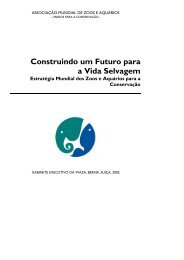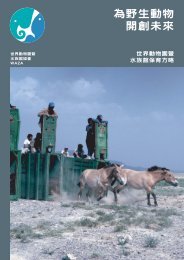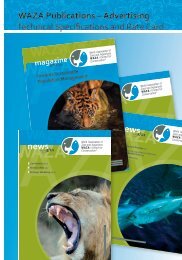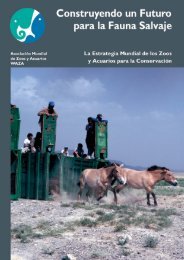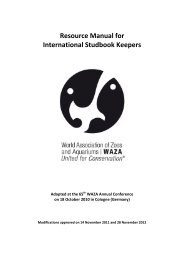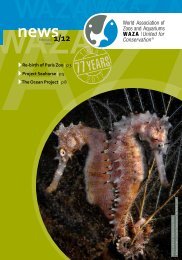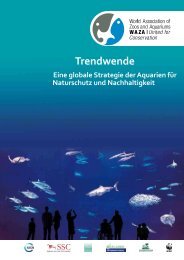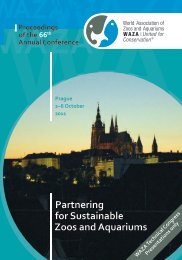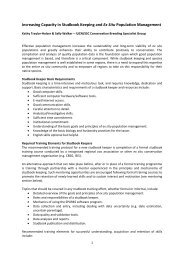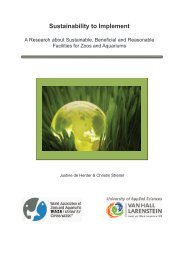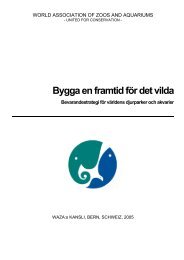Towards Sustainable Population Management - Waza
Towards Sustainable Population Management - Waza
Towards Sustainable Population Management - Waza
Create successful ePaper yourself
Turn your PDF publications into a flip-book with our unique Google optimized e-Paper software.
WAZA magazine Vol 12/2011 23<br />
Cheryl S. Asa 1 *, Kathy Traylor-Holzer 2 & Robert C. Lacy 2,3<br />
Mate Choice as a Potential Tool<br />
to Increase <strong>Population</strong> Sustainability<br />
The Sustainability<br />
Problem<br />
The sustainability of populations has<br />
become an important consideration<br />
for the zoo and aquarium community.<br />
In their analysis of 87 zoo mammal<br />
populations, Lees & Wilcken (2009)<br />
found that 52% were not breeding to<br />
replacement and that 67% fell below<br />
the threshold of 200 animals recommended<br />
by Baker (2007). Conway<br />
(2011) pointed out that new policies<br />
and practices in zoo collection management,<br />
including more specialisation<br />
and focused propagation efforts,<br />
are needed if zoos are to fulfil their<br />
conservation potential. Regional zoo<br />
associations are examining possible<br />
reasons for the unsustainability of<br />
their populations, but one clear factor<br />
is the failure of many assigned<br />
pairs to reproduce, often due to pair<br />
incompatibility. The typical reaction<br />
is to assign another breeding partner,<br />
often requiring the transfer of an<br />
animal to or from another location.<br />
This dating game may finally result in<br />
a successful match, but meanwhile<br />
valuable time and reproductive opportunities<br />
are lost.<br />
1 Saint Louis Zoo,<br />
St. Louis, MO, USA<br />
2 IUCN/SSC Conservation<br />
Breeding Specialist Group,<br />
Apple Valley, MN, USA<br />
3 Chicago Zoological Society,<br />
Brookfield, IL, USA<br />
* E-mail for correspondence:<br />
asa@stlzoo.org<br />
Female Choice and<br />
Reproductive Success<br />
In nature, many animals are able to<br />
choose their mates and the importance<br />
of female choice (females<br />
choosing their mates) has been<br />
documented in many different taxa<br />
(Asa et al. 2011). The factors affecting<br />
mate choice are not always apparent,<br />
but allowing animals to choose<br />
can increase pregnancy rates, litter<br />
sizes and offspring survival. There<br />
are many steps in the reproductive<br />
process, from courtship through<br />
rearing young to independence, and<br />
it appears that mate choice can affect<br />
most if not all of them. Most obviously,<br />
compatible pairs are more likely<br />
to copulate. A female that rejects<br />
mating attempts from a particular<br />
male will not conceive unless forced,<br />
but even when forced, females of at<br />
least some species can impede or<br />
prevent reproduction. Best studied<br />
in birds, females that mate with nonpreferred<br />
males can eject sperm or<br />
even influence the ability of sperm to<br />
fertilise ova. Females of some species<br />
influence embryo survival and litter<br />
size by restricting nutrients or differentially<br />
allocating hormones. Females<br />
can also withhold parental care<br />
and affect survival of offspring that<br />
result from non-preferred matings.<br />
Enhancing animal wellbeing and<br />
promotion of natural behaviours are<br />
goals of modern zoos. Allowing animals<br />
to select partners can contribute<br />
to the wellbeing of those individuals<br />
and better simulates their natural<br />
mating behaviour, contributing to<br />
something we sometimes refer to as<br />
the “happy factor”. Happy females<br />
(i.e. happy with their partners) are<br />
more likely to mate, conceive, incubate<br />
or carry a pregnancy to term and<br />
more likely to be good parents, also<br />
improving offspring wellbeing as well<br />
as survival.<br />
If mate choice is important to the<br />
reproductive success of most species,<br />
then preventing choice could<br />
be counterproductive to reaching<br />
programme objectives. The benefits<br />
from mate choice, for example higher<br />
birth or hatching rates and higher<br />
offspring survival plus enhanced<br />
animal wellbeing, are obvious. Higher<br />
reproductive success means higher<br />
probability of sustainability and faster<br />
growth to the population’s target<br />
size, which helps to slow the loss of<br />
genetic diversity. Allowing animals to<br />
exhibit natural reproductive behaviours<br />
also reduces the unintentional<br />
selection for traits that are adaptive<br />
to certain captive environments, but<br />
not adaptive to more natural environments<br />
for the species.<br />
Mate Choice and<br />
<strong>Population</strong> Genetics<br />
However, allowing mate choice is<br />
not without risk and may undermine<br />
genetic goals if animals choose mates<br />
that are genetically over-represented<br />
in the population (Asa et al. 2011).<br />
Numerous studies have shown that<br />
females make good genetic mate<br />
choices in terms of their own individual<br />
fitness and under the conditions<br />
in which they are living. Such choices,<br />
however, may not result in maximum<br />
retention of genetic diversity in the<br />
population, balance founder representation<br />
or avoid loss of adaptations<br />
to wild environments, which are the<br />
primary goals of captive breeding<br />
programmes (Lacy 1994).<br />
»



